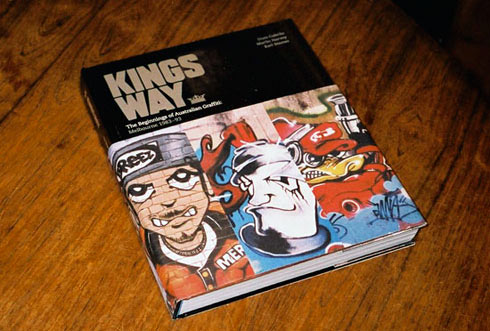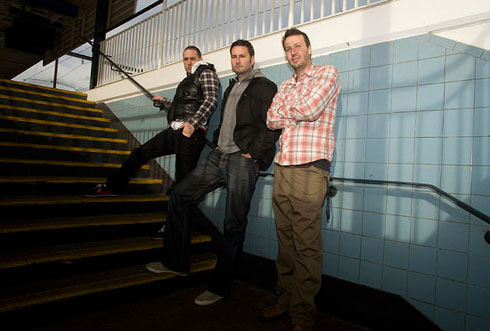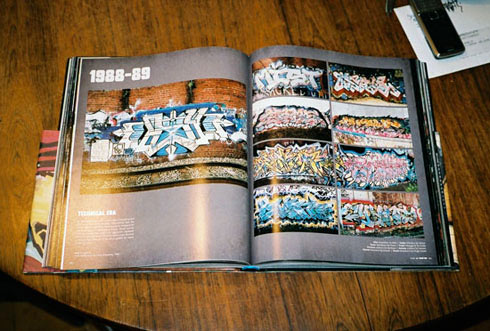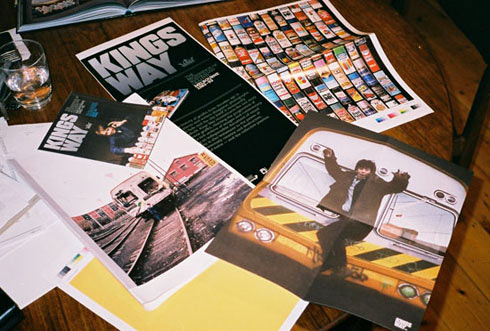Return Of The Kings



 Words: Tristan Ceddia Images: Tristan Ceddia & Jesse Marlow
Words: Tristan Ceddia Images: Tristan Ceddia & Jesse Marlow
This July sees the release of Melbourne’s inaugural graffiti book Kings Way. Already causing a stir in the mainstream media, the book is set to be Australia’s equivalent to New York’s Subway Art (1982). Tristan Ceddia caught up with the books co-author Duro Cubrillo at his Melbourne home last week for a sneak preview of the book.
Tristan Ceddia: Kings Way covers the formative years of the Melbourne graffiti scene from 1983 to 1993? Why did you choose to cover this period and where are you and your co-authors situated within this timeline?
Duro Cubrillo: I came up in the middle of this ten year period and so did Martin Harvey and Karl Stamer who I put the book together with. It made sense for us to cover those years – we knew what had come before us and were involved in what came after. We got in touch with people and got their stories and photos. The book begins with photos of some of the earliest graffiti in Melbourne. At this time we were all like, ‘What the Fuck is that? That’s fucking unbelievable – Sylvester the Cat and Goofy characters!’ At this early point, break dancing was really influential. Most of the graffiti at this early point was done by breakdancing crews influenced by the New York film Beat Street. Graffiti at this time was about crews, not individuals. Crews were going out and working on pieces together. Things have changed a lot since then. Now it’s all about me, me, me – it’s all about individuals focussed on what they can do.
TC: Ten years is a big gap to research and document in any scene. Was it a daunting task making sure you covered all the angles, or is this book something you had each been preparing for a long time?
DC: I hooked up with my mate Karl in 2001 at our mate Junior’s funeral, and he mentioned that we had to do a book. I think the beauty of this book, is that so many writers were willing to entrust me with their stories. Since the early days, Marty and myself have been graffiti scholars, always analysing who was doing what and where things were being done. We made a point of documenting what was going on the whole time, so when it came to putting the book together, we knew most of what needed to go in and what didn’t. Kings Way is a testament to the Melbourne scene.
TC: Kings Way is the only definitive book ever released to accurately document the Melbourne graffiti scene. Structuring such a definitive and historical book with so many different elements and areas to cover must have been a big job?
DC: It begins with walls, ends with trains and in the middle there’s bombing, each section runs chronologically from 1983-1993. It’s Melbourne from day one – documenting how the scene started, who was involved and how it evolved. It includes all the corners of the city – from Hursty, where we were from, to Frankston, Sandringham and everywhere in between. The sections are tied together with individuals writers and crews, we covered it all. The way it is, it sits nicely on the shelves next to New York’s Subway Art.
TC: The book is mostly image based, with little text bar brief quotes spread throughout the pages and a foreword. Did you feel that there were too many stories to be told with this publication so you limited it to mainly images?
DC: We wanted Kings Way to be presented as an image heavy art book. We culled 6000 images down to 1220 for the final edit – that didn’t leave us with much room for text! Every writer we talked to had a zillion different stories to tell so we had to stop and ask ourselves how we were going to get all the best stories into the book without bulking it out with too much text. In the end we decided that the images were strong enough to speak for themselves, and reserved the text to minimal quotes detailing what we felt fitted in nicely.
TC: At the best of times, the graffiti scene is ripe with bad blood and inflated ego’s. Kings Way seems to avoid all of this and present a clean look at the Melbourne scene. Did you run into any ego problems?
DC: The book is so much bigger than the individual, that’s kind of the point. We’re passionate about graffiti and passionate about it being remembered. That said, this book isn’t about us. Without the contributors who gave us their memories, the book would have been nothing. It’s a community project. The look on peoples faces when they see the book is phenomenal, seeing that expression shows how much it means to people. For a lot of these writers, graffiti was the only time in their life when they were actually doing something they loved.
TC: There’s a small tribute to a character called Ron The Train Driver in the book. How many people and sources contributed images and stories to the book?
DC: In total there were 60 photo contributors but there were probably about seven who contributed the most. They are mostly really early graff writers who did a lot to document the scene back in the day. Ron the Train Driver is one of the main contributors to the book and was an important figure known in the scene. He was the Henry Chalfant or Martha Cooper of Melbourne. He used to stop trains to take photos and would then hand them out to writers at Richmond station at the bench. He was a train driver who had a fascination with graffiti so he started documenting if from day one. He took a lot of the people shots that are shown in the book. If you didn’t get a photo of your piece you would ring him up and chances were he would have it!
TC: Of late, Melbourne has come to be known as the street art capital of the world. This title has come along with an influx of books badly representing Melbourne’s crossover graffiti and street art scenes. Does Kings Way attempt to return Melbourne’s focus to proper graffiti or is this book more about documentation and presenting a culture?
DC: Lots of people think the two are the same thing, but they’re not. Graffiti has been a stand alone sub-culture within its own right here since 1983, though it was a New York thing long before that. People think that street art has been around that long, but in terms of a subculture, it really is a new age thing. The only common thread between them is the space and materials. Writing has to be acknowledged as a stand alone sub-culture and not be packaged up with street art. The scene needs to move forward and be documented and accepted like in New York. They have so much documentation and literature about their scene, so why can’t Melbourne have the same thing?
Kings Way is available at good bookstores Australia wide and online as of July 1 2009
Next Article



